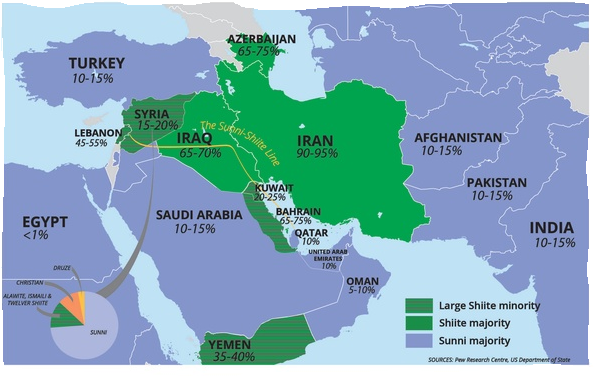The Imami Shiites also known as the Twelvers are traceable to the eleventh imam known as Hasan al-Askari (Martin 351). However, the Imami Shiites only came into existence after the death of the imam in 874 (Martin 350). The Imami Shiites are known for social and political leadership.
Imami Shiites are found in Lebanon, Iraq and Syria (Nasr 58). Other regions where the Imami Shiites are found include India, Yemen, Turkey, Iran, Afghanistan and Pakistan (Nasr 60).
The population of the Imami Shiites in the Middle East as compared to the rest of the Shia Islam is twenty percent (Nasr 61). Population trends imply that the number of Imami Shiites in Central Asia has increased during the 20th century.

Fig 1.0 a representation of the Shiite population in the Muslim world
For a long time, the Imami Shiites have succeeded in influencing the rest of the Muslim population (Haynes 111). The idea of ensuring that Islam leadership is entitled to an Imam has always led to a political debate between the Shiites and the Sunni.
The struggle by the Shiites to control the Muslim world through religious doctrines led to the political tension between the Israel and the Arab world.
The early dominance of politics in Lebanon and Syria by the Imami Shiites led to an unending conflict between Islam and Judaism. Apparently, the Imami Shiites have always believed that Israel occupation is illegal.
While the Imami Shiites continue to agitate for political leadership that reflects the image of Prophet Muhammad, the Sunni prefers dictatorship. In this regard, the dominance of political dictators and monarchy in the Middle East flourished from the 1900s to early 21st century.
For example, the establishment of dictatorial leadership in Iraq, Syria and Egypt resulted from power struggles between the Imami Shiites and the Sunni. On the other hand, the dominance of monarchy rule in countries like the United Arab Emirates, Oman, Saudi Arabia and Turkey has continued for many years (Haynes 112).
The political influence of the Imami Shiites in Iran has had a positive impact. Apparently, the Imami Shiites are credited for building religious institution such as the hoseiniyeh that was fundamental to the Tehran revolution of 1979.
In addition, the Imami Shiites are credited for promoting both religious and secular education in the Middle East by constructing madrasehs and maktabs. From such institutions, scholars known as ayatollahs are nurtured.
An example of the current Iranian leader known as Ayatollah Ali Khamenei shows how the Imami Shiites continue to influence politics in the Middle East (Haynes 303).
Currently, the power struggles between Shiites sects are still evidenced from political intolerance. The exiling of the Ismailia Shiites to India is an example of how political intolerance still exists in countries where Imami Shiites enforce Sharia law.
The dominance of the Imami Shiite in the politics of Eastern Turkey is hailed for ending the Ottoman Empire preferred by the Sunni. In addition, the role of the Imami Shiites in stabilizing Persia is noted as a historical achievement especially by the Mughal Muslims in India.
In conclusion, the continued political struggle by the Imami Shiites is similar to the group’s religious conflict with the Sunni. In fact, the political rivalry of the group with other Islam groups has now become a conflict between the Arabs and Persians.
Works Cited
Haynes, Jeffrey. Routledge handbook of religion and politics. New York: Routledge, 2008. Print.
Martin, C. Richard. Encyclopedia of Islam & the Muslim World. San Diego: Granite Hill Publishers, 2004. Print.
Nasr, Vali. “When the Shiites rise.” Foreign Affairs (2006): 58-74. Print.